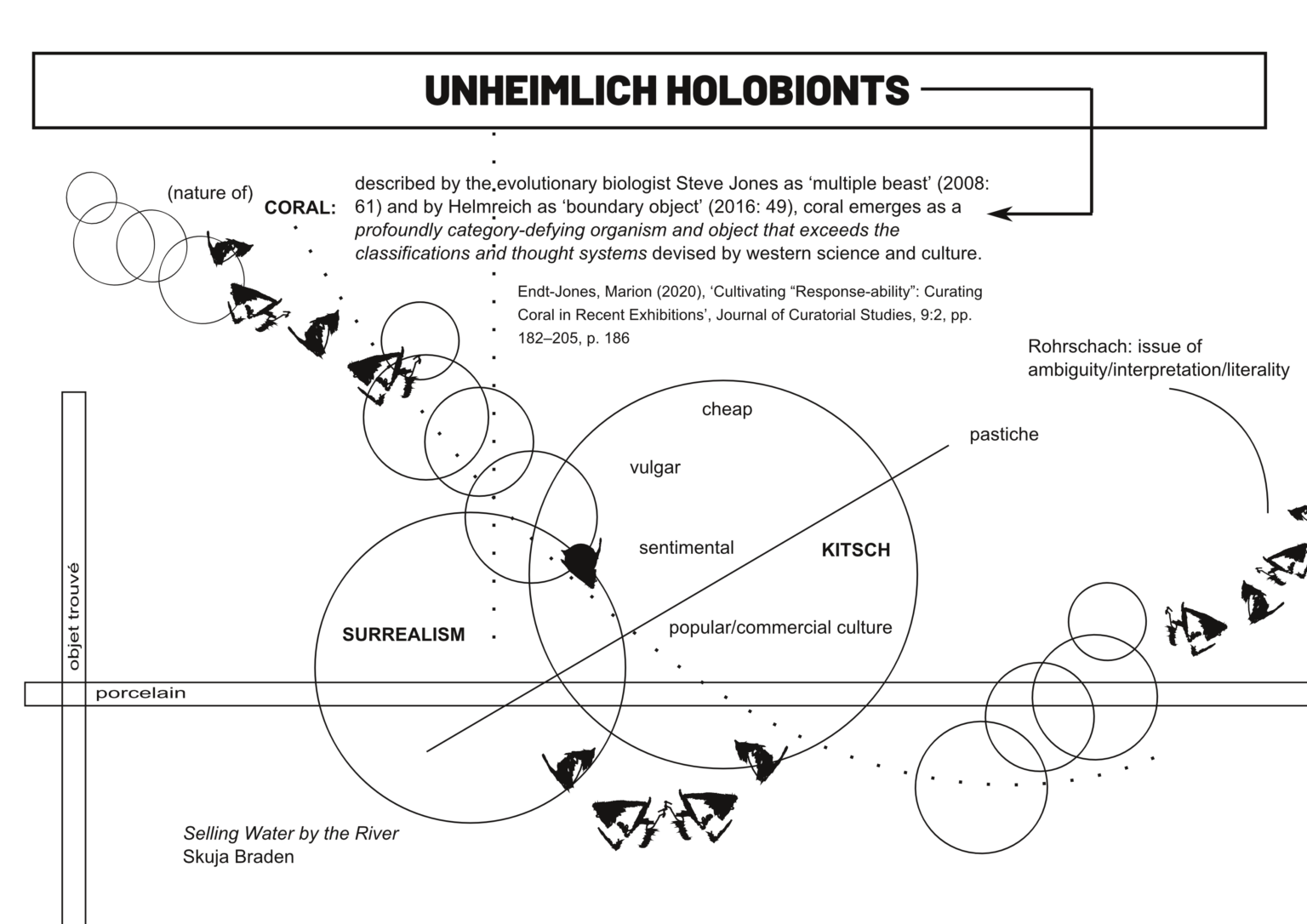Dear Dineke Oosting,
Does your work have a specific smell? Does it smell like plastic?
Did you see that there are a few dead bugs laying on the synthetic fur carpet?
Dear Oosting,
To appreciate the symbolic meaning of your artwork in PITCAIRN space, I needed to first understand what the word feeling rich signifies.
Is it actually masking reality with cheaply produced yet fancy-looking goods?
Is it our forcibly injected desire to consume what fast fashion industries offer?
Is it the work that represents its loss of an aura, being a cheap replica found in a second-hand store?
I am at a loss for words as I watch your work, dear Oosting. Instead, I have decided to answer the questions I asked you with a few cliche art theoretical quotes from somebody else.
Is it actually masking the reality with cheaply produced yet fancy-looking goods?
“it is the reflection of a profound reality;
it masks and denatures a profound reality;
it masks the absence of a profound reality;
it has no relation to any reality whatsoever;
it is its own pure simulacrum.” 1
Is it our forcibly injected desire to consume what the fast fashion industries offer?
“You see, the object of desire is the cause of the desire [object a], and this object that is the cause of desire is the object of the drive – that is to say, the object around which the drive turns…. It is not that desire clings to the object of the drive – desire moves around it, in so far as it is agitated in the drive.” 2
Is it the work that represents in itself the loss of an aura, where the meaning got lost in a second-hand store?
“In the light of this description, we can readily grasp the social basis of the aura’s present decay. It rests on two circumstances, both linked to the increasing emergence of the masses and the growing intensity of their movements. Namely: the desire of the present-day masses to “get closer” to things, and their equally passionate concern for overcoming each thing’s uniqueness [Oberwindung des Einmaligen jeder Gegebenheit] by assimilating it as a reproduction. Every day the urge grows stronger to get hold of an object at close range in an image [Bild], or, better, in a facsimile [Abbild], a reproduction. And the reproduction [Reprodulction], as offered by illustrated magazines and newsreels, differs unmistakably from the image. Uniqueness and permanence are as closely entwined in the latter as are transitoriness and repeatability in the former. The stripping of the veil from the object, the destruction of the aura, is the signature of a perception whose “sense for all that is the same in the world” so increased that, by means of reproduction, it extracts sameness even from what is unique.“ 3
In the meantime, I can pretend to know the answers and write some sort of analysis with regard to your work, but that would only make me feel like the phony golden chain you hung in the PITCAIRN space. Why do I feel agitated while writing this letter to you, attempting to grasp the notion of feeling rich?
Dear Oosting,
To be truthful, I feel the richest in my memories. This brings me back to my childhood when my Christian grandfather would claim that one feels rich in the presence of God. Yet, he has never fulfilled a true Christian believer’s path and rather took religion as a means to be seen as a man of faith.
Or my great-grandmother, who repeatedly told me that health, joy, and family are the main ingredients for feeling rich, since feeling, appearing, or being rich before I was born was seen as an enemy of the Soviet State. According to her, no one was able to be rich during the Soviet occupation and those who seemed to be rich were inspected by KGB agents.
I remember a nun lecturer who, ironically, secretly believed more in philosophy than religion and who initially exposed me to Greek philosophy. From which I now realize my great-grandmother secretly lived a eudaimonic life. It was Aristotle who fancifully used the Greek word eudaimonia to define happiness, which he believed to be the same as leading a life worth living. Worthiness, that is, living out of virtue without praising material goods.
On the other hand, I remember family holidays in Turkey, where my mother would purchase fake designer bags. After seeing your work/statement which I will presumably apply as that of addressing consumerist society, I wonder if my mother’s purchase was made to make her feel rich.
Another recollection that sparked in my mind while thinking of your work, was a brother of my father. He too enjoyed sparkling golden necklaces that he would occasionally scout on online auctions.
But I suppose the richest memory that could best resonate with your work was a life declaration from a friend of mine. Somewhere along the lines of a great Greek philosopher, Diogenes the Cynic. 15 years ago, he intentionally opted to live the life of a homeless. On top of that, he chose to completely ignore any kind of footwear throughout all four seasons! Whenever I asked him how he felt, he always reassured me that he was the richest man in the world. Although, I never managed to ask under what actual circumstances he ended up living under the bridge.
Dear Oosting,
Excuse my incompetence in formulating a coherent letter. I aimed to find another allegory to the phrase you used for your installation piece. However, I ended up seeking differentiating allegories by observing what could be summoned up by the phrase feeling rich.
Yours,
Klaudija Ylaite
1Baudrillard, Jean. Simulacra and Simulation. Ann Arbor, The University of Michigan Press, 1994. p.6
2 Lacan, Jacques. The Seminar of Jacques Lacan. Book 11, Four Fundamental Concepts of Psychoanalysis. New York, Norton, 1998. P.243
3 Benjamin, W., Jennings, M. W., Doherty, B., & Levin, T. Y. (2008). The work of art in the age of its technological. p.23-24
Location
Gedempte Zuiderdiep 132
9711 HM
Groningen
Opening Hours
Opened Daily 24/7
Free of charge
© Pitcairn 2022



